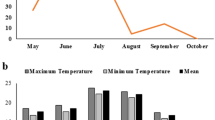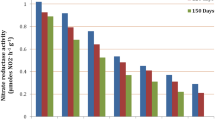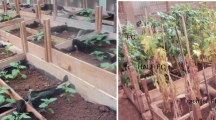Summary
Salt tolerance in Andean potatoes can be a source for this trait in cultivated potatoes or be exploited to expand potato cultivation to more marginal areas. The purpose of this study was to determine salt tolerance in twelve Argentine Andean potato varieties through the response of nodal segments cultured in vitro and to evaluate whether changes in Na+, K+ or proline accumulation associate with salt tolerance. Genotypes Bianca, Airampia, Sisa Sani and Cuarentilla were the most tolerant. The most susceptible varieties were Balcacha, Runa Rosada, Collareja, Overa, Bianca Redonda and Papa Baya, while Cuarentona and Colorado Ml comprised an intermediate group. These results indicate that variability for salt tolerance exists in this germplasm, and highlights its potential use in breeding programmes. No association was found between the salt tolerance rating and changes in K+, Na+ and proline accumulation in a salt gradient, thus precluding the use of these parameters as predictors for salt tolerance of these species in in vitro studies.
Similar content being viewed by others
References
Ahmad, R. & Z.U.N. Abdullah, 1979. Salinity induced changes in the growth and chemical composition of potato.Pakistan Journal of Botany 11: 103–112.
Amzallag, G.N. & H.R. Lerner, 1995. Adaptation versus pre-existing resistance: an intergenotype analysis of the response ofSorghum bicolor to salinity.Plant Sciences 42: 125–141.
Bates, L.S., 1973. Rapid determination of free proline for water-stress studies.Plant and Soil 39: 205–207.
Bilski, JJ., D.C. Nelson & R.L. Conlon, 1988. The response of four potato cultivars to chloride salinity, sulfate salinity and calcium in pot experiments.American Potato Journal 65: 85–90.
Cano, E.A., F.C. Bolarín, F. Perez-Alfocea & M. Caro, 1991. Effect of NaCl priming on increased salt tolerance in tomato.Journal of Horticultural Science 66: 621–628.
Cano, E.A., F. Pérez-Alfocea, A. Moreno, M. Caro & M.C. Bolarin, 1998. Evaluation of salt tolerance in cultivated and wild tomato species through in vitro shoot apex culture.Plant Cell, Tissue and Organ Culture 53: 19–26.
Chávez, R., H. Mendoza, J. Espinoza, J. Flores, J. Chavez & P. Siles, 1994. Ampliando la base genética para resistencia a salinidad y sequía en el germoplasma mejorado de papa y camote.Revista Nueva Imagen 5: 13–27.
Cramer, G.R., G.J. Alberico & C. Schmidt, 1994. Salt tolerance is not associated with the sodium accumulation of two maize hybrids.Plant Physiology 21: 675–692.
Ekanayake, I.J. & J.H. Dodds, 1993. In vitro testing for the effects of salt stress on growth and survival of sweet potato.Scientia Horticulturae 55: 239–348.
Flowers, T.J., M.A. Hagibagheri & N.J.W. Clipson, 1986. Halophytes.The Quarterly Review of Biology 61: 313–337.
Flowers, T.J. & A. Läuchli, 1983. Sodium versus potassium: substitution and compartmentation. In: A. Läuchli & R.L. Bieleski (Ed.), Encyclopedia of Plant Physiology, New Series. Springer Verlag, New York, pp. 651–681.
Greenway, H. & R. Munnus, 1980. Mechanisms of salt tolerance in non halophytes.Annual Review of Plant Physiology 31: 149–190.
Hannemann, R.E., 1989. The potato germplasm resource.American Potato Journal 66: 655–667.
Hawkes, J.G., 1990. The Potato. Evolution, biodiversity and genetic resources. Belhaven Press, London.
Jefferies, R.A., 1996. Evaluation of seedling selection for salinity tolerance in potatoSolanum tuberosum L.Euphytica 88: 207–213.
Khrais, T., Y. Leclerc & D.J. Donnelly, 1998. Relative salinity tolerance of potato cultivars asessed by in vitro screening.American Journal of Potato Research 75: 207–210.
Läuchli, A. & E. Epstein, 1984. How plants adapt to salinity. Mechanisms of salt tolerance in plants.California Agriculture 38: 18–20.
Levy, D., 1992. The response of potatoesSolanum tuberosum L. to salinity: plant growth and tuber yields in the arid desert of Israel.Annals of Applied Biology 120: 547–555.
Levy, D., E. Fogelman & Y. Itzhak, 1988. The effect of water salinity on potatoesSolanum tuberosum L.: Physiological indices and yielding capacity.Potato Research 31: 601–610.
Levy, D. & D. Magnusson, 1989. The response of potatoes to salinity under field conditions. Report, The Volcani Center, pp. 14–22.
Maas, E.V. & G.J. Hoffman, 1977. Crop salt tolerance. Current assessment.Journal of the Irrigation and Drainage Division, ASCE 102: 115–134.
Mahmood, A. & S.A. Quarrie, 1993. Effects of salinity on growth, ionic relations and physiological traits of wheat, disomic addition lines fromThinopyrum bessarabicum, and two amphiploids.Plant Breeding 110: 265–276.
Martinez, C, M. Maestri & E. Lani, 1996. In vitro salt tolerance and proline accumulation in Andean potatoSolanum spp. differing in frost resistance.Plant Science 116: 177–184.
Morpurgo, R., 1991. Correlation between potato clones grown in vivo and in vitro under sodium chloride stress conditions.Plant Breeding 107: 80–82.
Munns, R., 1993. Physiological processes limiting plant growth in saline soils: some dogmas and hypotheses.Plant, Cell and Environment 16: 15–24.
Murashige, T. & F. Skoog, 1962. A revised medium for rapid growth and bioassay with tobacco tissue culture.Physiologia Plantarum 15: 473–479.
Naik, P.S. & J.M. Widholm, 1993. Comparison of tissue culture and whole plant responses to salinity in potato.Plant Cell, Tissue and Organ Culture 33: 273–280.
Niu, X., R.A. Bresssan, P.M. Hasegawa & J.M. Pardo, 1995. Ion homeostasis in NaCl stress environments.Plant Physiology 109: 735–742.
Potluri, S.D.P. & P.V. Devi Prasad, 1993. Influence of salinity on axillary bud of six lowland tropical varieties of potato.Plant Cell, Tissue and Organ Culture 32: 185–191.
Potluri, S.D.P. & P.V. Devi Prasad, 1994. Salinity effects on in vitro perfomance of some cultivars of potato.Revista Brasileira de Fisiologia Vegetal 1: 1–6.
Ross, H., 1986. Potato breeding, problems and perspectives. Advances in Plant Breeding Suppl. 13. Verlag Paul Parey, Berlin, 132 pp.
Sabbah, S. & M. Tal, 1995. Salt tolerence inSolanum kurzianum andS. tuberosum cvs Alpha and Russet Burbank.Potato Research 38: 319–330.
Storey, R. & R.G. Wyn Jones, 1978. Salt stress and comparative physiology in the Gramineae. I. Ion relations of two salt- and water-stressed barley cultivars, California Mariout and Arimar.Australian Journal of Plant Physiology 5: 801–816.
Subbarao, G.V., C. Johansen, J.V.D.K. Kumar Rao & M.K. Jana, 1990. Salinity tolerance in Fl hybrids of pigeonpea and a tolerant wild relative.Crop Science 30: 785–788.
Swaay, A.C.E. van, E. Jacobsen, J.A. Keil & W.J. Feenstra, 1986. Selection, characterization and regeneration of hydroxiproline-resistant cell lines ofSolanum tuberosum L.: tolerance to NaCl and freezing streess.Physiologia Plantarum 68: 359–366.
Yeo, A.R. & T.J. Flowers, 1984. Non osmotic effects of polyethylene glycols upon sodium transport and sodium-potassium selectivity by rice roots.Plant Physiology 75: 298–303.
Zhang, Y. & D.J. Donnely, 1997. In vitro bioassays for salinity tolerance screening of potato.Potato Research 40: 285–295.
Author information
Authors and Affiliations
Corresponding author
Rights and permissions
About this article
Cite this article
Velásquez, B., Balzarini, M. & Taleisnik, E. Salt tolerance variability amongst Argentine Andean potatoes (Solanum tuberosum L. subsp.andigena). Potato Res. 48, 59–67 (2005). https://doi.org/10.1007/BF02733682
Accepted:
Issue Date:
DOI: https://doi.org/10.1007/BF02733682




